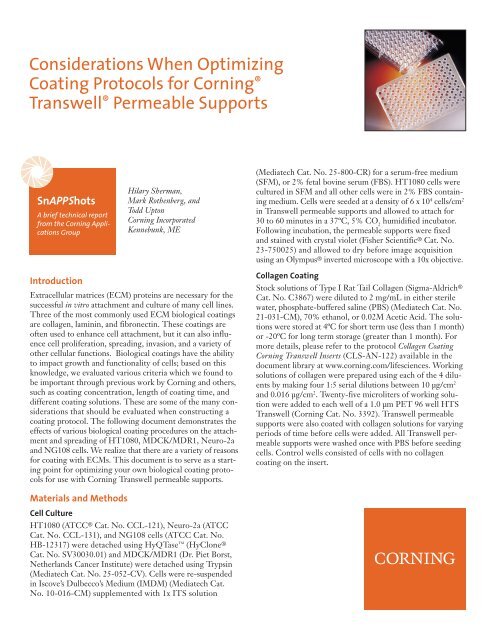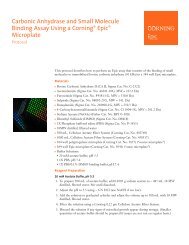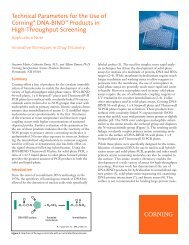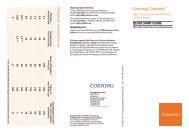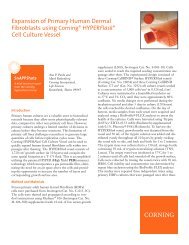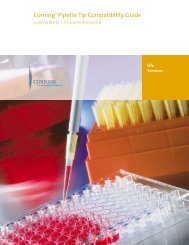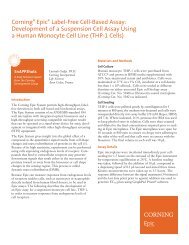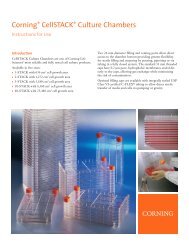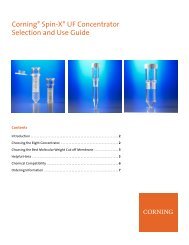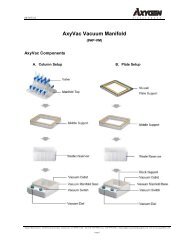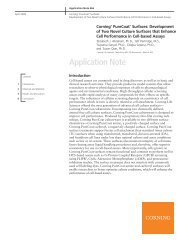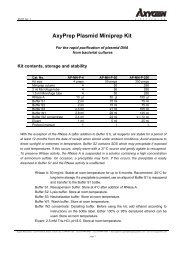Considerations When Optimizing Coating Protocols for Corning ...
Considerations When Optimizing Coating Protocols for Corning ...
Considerations When Optimizing Coating Protocols for Corning ...
You also want an ePaper? Increase the reach of your titles
YUMPU automatically turns print PDFs into web optimized ePapers that Google loves.
<strong>Considerations</strong> <strong>When</strong> <strong>Optimizing</strong><strong>Coating</strong> <strong>Protocols</strong> <strong>for</strong> <strong>Corning</strong> ®Transwell ® Permeable SupportsSnAPPShotsA brief technical reportfrom the <strong>Corning</strong> ApplicationsGroupHilary Sherman,Mark Rothenberg, andTodd Upton<strong>Corning</strong> IncorporatedKennebunk, ME(Mediatech Cat. No. 25-800-CR) <strong>for</strong> a serum-free medium(SFM), or 2% fetal bovine serum (FBS). HT1080 cells werecultured in SFM and all other cells were in 2% FBS containingmedium. Cells were seeded at a density of 6 x 10 4 cells/cm 2in Transwell permeable supports and allowed to attach <strong>for</strong>30 to 60 minutes in a 37ºC, 5% CO 2humidified incubator.Following incubation, the permeable supports were fixedand stained with crystal violet (Fisher Scientific ® Cat. No.23-750025) and allowed to dry be<strong>for</strong>e image acquisitionusing an Olympus ® inverted microscope with a 10x objective.IntroductionExtracellular matrices (ECM) proteins are necessary <strong>for</strong> thesuccessful in vitro attachment and culture of many cell lines.Three of the most commonly used ECM biological coatingsare collagen, laminin, and fibronectin. These coatings areoften used to enhance cell attachment, but it can also influencecell proliferation, spreading, invasion, and a variety ofother cellular functions. Biological coatings have the abilityto impact growth and functionality of cells; based on thisknowledge, we evaluated various criteria which we found tobe important through previous work by <strong>Corning</strong> and others,such as coating concentration, length of coating time, anddifferent coating solutions. These are some of the many considerationsthat should be evaluated when constructing acoating protocol. The following document demonstrates theeffects of various biological coating procedures on the attachmentand spreading of HT1080, MDCK/MDR1, Neuro-2aand NG108 cells. We realize that there are a variety of reasons<strong>for</strong> coating with ECMs. This document is to serve as a startingpoint <strong>for</strong> optimizing your own biological coating protocols<strong>for</strong> use with <strong>Corning</strong> Transwell permeable supports.Collagen <strong>Coating</strong>Stock solutions of Type I Rat Tail Collagen (Sigma-Aldrich ®Cat. No. C3867) were diluted to 2 mg/mL in either sterilewater, phosphate-buffered saline (PBS) (Mediatech Cat. No.21-031-CM), 70% ethanol, or 0.02M Acetic Acid. The solutionswere stored at 4ºC <strong>for</strong> short term use (less than 1 month)or -20ºC <strong>for</strong> long term storage (greater than 1 month). Formore details, please refer to the protocol Collagen <strong>Coating</strong><strong>Corning</strong> Transwell Inserts (CLS-AN-122) available in thedocument library at www.corning.com/lifesciences. Workingsolutions of collagen were prepared using each of the 4 diluentsby making four 1:5 serial dilutions between 10 µg/cm 2and 0.016 µg/cm 2 . Twenty-five microliters of working solutionwere added to each well of a 1.0 µm PET 96 well HTSTranswell (<strong>Corning</strong> Cat. No. 3392). Transwell permeablesupports were also coated with collagen solutions <strong>for</strong> varyingperiods of time be<strong>for</strong>e cells were added. All Transwell permeablesupports were washed once with PBS be<strong>for</strong>e seedingcells. Control wells consisted of cells with no collagencoating on the insert.Materials and MethodsCell CultureHT1080 (ATCC ® Cat. No. CCL-121), Neuro-2a (ATCCCat. No. CCL-131), and NG108 cells (ATCC Cat. No.HB-12317) were detached using HyQTase (HyClone ®Cat. No. SV30030.01) and MDCK/MDR1 (Dr. Piet Borst,Netherlands Cancer Institute) were detached using Trypsin(Mediatech Cat. No. 25-052-CV). Cells were re-suspendedin Iscove’s Dulbecco’s Medium (IMDM) (Mediatech Cat.No. 10-016-CM) supplemented with 1x ITS solution
Fibronectin and Laminin <strong>Coating</strong>Fibronectin and laminin were purchased from Sigma-Aldrich ®(Cat. No. L2020 and F1141, respectively) and aliquoted <strong>for</strong>storage as described above. For a more detailed protocol onfibronectin or laminin coating of Transwell inserts, pleaserefer to CLS-AN-150 and CLS-AN-149 in the documentlibrary at www.corning.com/lifesciences. Multiple concentrationswere used to coat the permeable supports <strong>for</strong> varyingperiods of time using either PBS or serum-free medium(SFM) as a diluent. As many protocols call <strong>for</strong> polymerizinglaminin at 37ºC, this was also examined. All inserts werewashed once with PBS be<strong>for</strong>e seeding cells, and controlwells consisting of uncoated inserts were included.ResultsThe following applications were per<strong>for</strong>med to address frequentlyasked questions about coating ECM proteins onTranswell permeable supports using three commonlyused biological coatings: collagen, fibronectin, and laminin.Twenty-five microliters of working solution were added toeach well of a 1.0 µm PET 96 well HTS Transwell (<strong>Corning</strong>Cat. No. 3392) and allowed to coat <strong>for</strong> varying periods oftime be<strong>for</strong>e adding cells. Fig. 1A shows HT1080 cells oncollagen cultured after 30 minutes <strong>for</strong> attachment in SFM.MDCK/MDR1 cells cultured in 2% FBS medium were alsotested giving similar results (data not shown). The micrographsshow that cell attachment and spreading is dependentnot only on coating concentration, but also coating time.Similar results were obtained when coated at 10 µg/cm 2 <strong>for</strong>30 minutes as compared to a 0.08 µg/cm 2 <strong>for</strong> 24 hours.We also examined various solutions <strong>for</strong> diluting collagen(Fig. 1B). Example micrographs of HT1080 cells attachingto inserts that were coated at 0.4 µg/cm 2 <strong>for</strong> 30 minutes areshown above. No difference in cell spreading was observedat any time point or coating concentration, regardless of thediluent used (data not shown).Figure 1. HT1080 Cells on Collagen-Coated Transwell® Permeable SupportsA.<strong>Coating</strong>Concentration24 hours 6 hours 30 minutes10 µg/cm 2Uncoated2 µg/cm 20.4 µg/cm 20.08 µg/cm 2B.PBS DiH 20 70% Ethanol 0.02 Acetic Acid0.4 µg/cm 2<strong>for</strong> 30 min.
The micrographs below show that cell spreading wasimproved when SFM was used to dilute fibronectin ascompared to PBS (Fig. 2). The micrographs also show thatsimilar cell spreading can be achieved when cultured onfibronectin <strong>for</strong> 30 minutes or 24 hours, depending on theconcentration of fibronectin used.Laminin, another coating used to promote cell attachmentand spreading, was also tested under the same conditions asabove using Neuro-2a and NG108 cells (NG108 data notshown) (Fig. 3A). It was found that coating times of 24 hoursnegatively impacted cell spreading (data not shown). No differencewas observed in cell spreading regardless of diluentused. Various coating concentrations and coating times werealso compared using laminin that was coated at 37ºC and atroom temperature (25ºC) (Fig. 3B).DiscussionIn summary, we have found the effectiveness of biologicalcoatings to be directly related to coating concentration andcoating time. Our data suggests that similar results can beachieved with either a short coating time with high concentrationsor a long coating time with lower concentrations.By monitoring cell spreading of multiple cell lines dilutedwith various reagents, it was found that the effect on cellattachment can be dependent on the diluent used as well asthe temperature at which the coating was applied. Theseresults suggest that each diluent should be examined carefullywhen setting up experimental conditions. To improveexpermental results when coating Transwell permeable supports,we recommend optimizing coating time, concentrationand diluent used.Figure 2. HT1080 Cells on Fibronectin-Coated Transwell ® Permeable Supports<strong>Coating</strong>Time<strong>Coating</strong>Concentration<strong>Coating</strong> <strong>Coating</strong>PBS SFM Time Concentration PBS SFM10 µg/cm 210 µg/cm 224 hours2 µg/cm 230minutes2 µg/cm 20.4 µg/cm 20.4 µg/cm 210 µg/cm 2Uncoated6 hours2 µg/cm 20.4 µg/cm 2
Figure 3. Neuro-2a Cells on Lamininn-Coated Transwell ® Permeable SupportsA.<strong>Coating</strong>Time<strong>Coating</strong>ConcentrationPBSSFM<strong>Coating</strong>Time<strong>Coating</strong>ConcentrationPBSSFM10 µg/cm 210 µg/cm 26 hours2 µg/cm 230minutes2 µg/cm 21 µg/cm 21 µg/cm 210 µg/cm 2Uncoated2 hours2 µg/cm 2B.SFM at RT SFM at 37°C10 µg/cm 2<strong>for</strong> 2 hours1 µg/cm 2<strong>Corning</strong> IncorporatedLife SciencesTower 2, 4th Floor900 Chelms<strong>for</strong>d St.Lowell, MA 01851t 800.492.1110t 978.442.2200f 978.442.2476www.corning.com/lifesciencesWorldwideSupport OfficesA S I A / PA C I F I CAustralia/New Zealandt 0402-794-347Chinat 86-21-5467-4666f 86-21-5407-5899Indiat 91 124 4604000f 91 124 4604099<strong>Corning</strong> and Transwell are registered trademarks of <strong>Corning</strong> Incorporated, <strong>Corning</strong>, NY.All other trademarks in this document are the property of their respective owners.<strong>Corning</strong> Incorporated, One Riverfront Plaza, <strong>Corning</strong>, NY 14831-0001Japant 81 3-3586 1996f 81 3-3586 1291Koreat 82 2-796-9500f 82 2-796-9300Singaporet 65 6733-6511f 65 6861-2913Taiwant 886 2-2716-0338f 886 2-2716-0339E U R O P EFrancet 0800 916 882f 0800 918 636Germanyt 0800 101 1153f 0800 101 2427The Netherlandst 31 20 655 79 28f 31 20 659 76 73United Kingdomt 0800 376 8660f 0800 279 1117All Other EuropeanCountriest 31 (0) 20 659 60 51f 31 (0) 20 659 76 73L AT I N A M E R I C ABrasilt (55-11) 3089-7419f (55-11) 3167-0700Mexicot (52-81) 8158-8400f (52-81) 8313-8589© 2010 <strong>Corning</strong> Incorporated Printed in USA 3/10 POD CLS-AN-134


